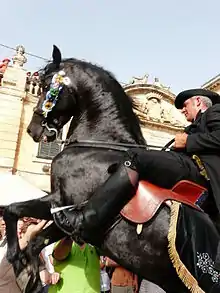Menorquín horse
The Menorquín or Catalan: Cavall Menorquí is a breed of horse indigenous to the island of Menorca in the Balearic Islands, from which it takes its name. It is closely associated with the doma menorquina style of riding.
 Menorquín horse and rider | |
| Conservation status | FAO 2007: endangered |
|---|---|
| Other names |
|
| Country of origin | Spain |
| Distribution | Menorca |
| Traits | |
| Height |
|
| Colour | black |
| Breed standards | |

History
Menorca was under Moorish domination from 903 to 1287. According some sources, research has shown links between the Menorquín and Arab breeds, while others have shown it to be of Berber origin, and yet others believe that it was brought to Menorca from central Europe by King James I of Aragon.[1] According to the Government of the Balearic Islands, it belongs to the eastern group of indigenous Iberian horses which also included the now extinct Catalan horse.[2]
The Menorquín was officially recognised as an indigenous breed in 1989,[3] and is listed in the Catálogo Oficial de Razas de Ganado de España in the group of autochthonous breeds in danger of extinction.[4] The FAO lists it as "endangered".[5] In April 2011 the total population was reported to be 2995, of which fewer than 200 were outside the Balearic Islands.[6] A breeders' association, the Associació de Criadors i Propietaris de Cavalls de Raça Menorquina, was formed in August 1988.[7]
The breed has remained agile and slender as it was not employed for agricultural work, for which the Balearic donkey was traditionally used.[8]
Characteristics
The Menorquín may only be black, in all its variations; horses of any other colour cannot be registered. Limited white markings are permitted. It is harmoniously made, tranquil and obedient, noble and elegant. The average height is 1.60 metres (15.3 hands),[9] and the minimum permissible height 1.54 m (15.1 h) for males and 1.51 m (14.3 h) for mares.[10] The profile is slightly convex, the body and limbs long, the eye round and lively. It is strong and energetic, slender, powerful and muscular and suited to any type of saddle or driving use. Its most valued quality is its suitability for the traditional festivals of Menorca, where it is irreplaceable, and for the elevade and bot movements of the doma menorquina.[2][1]
See also
References
| Wikimedia Commons has media related to Menorquin horse. |
- El Caballo Menorquín (in Spanish). Yeguada Binibernat. Archived 26 March 2012.
- Razas Autóctonas de las Illes Balears: Caballo mallorquín: Datos generales (in Spanish). Govern de las Illes Balears. Archived 24 September 2018.
- Martin Haller, Ulrike Schaeben (April–June 2011). Menorca – Insel der Pferde (in German). Equus (2011:02): 18–23. Archived 26 March 2012.
- Catálogo oficial de razas: Raza Autóctona en Peligro de Extinción (in Spanish). Ministerio de Agriculturo, Pesca y Alimentación. Accessed July 2019.
- Beate Scherf (editor) (2000). World Watch List for domestic animal diversity. third edition. Rome: Food and Agriculture Organization of the United Nations. ISBN 9251045119. Accessed April 2011.
- Raza equino caballar Menorquina (in Spanish). Ministerio de Agriculturo, Pesca y Alimentación. Accessed July 2019.
- La nostra associació (in Catalan). Associació de Criadors i Propietaris de Cavalls de Raça Menorquina. Accessed July 2011.
- Traditions and fiestas. Consell Insular de Menorca. Archived 2 May 2003.
- Menorquina (in Spanish). Federación Española de Asociaciones de Ganado Selecto. Archived 26 March 2012.
- Carlos Javier Escribano Mora (23 March 2010).Resolución de 23 de marzo de 2010, de la Dirección General de Recursos Agrícolas y Ganaderos, por la que se publica la Resolución de 10 de marzo de 2010, por la que se aprueba la reglamentación específica del Libro Genealógico y del Programa de Mejora de la Raza Equina Menorquina (in Spanish). Ministerio de Medio Ambiente y Medio Rural y Marino: Dirección General de Recursos Agrícolas y Ganaderos. Accessed July 2019.